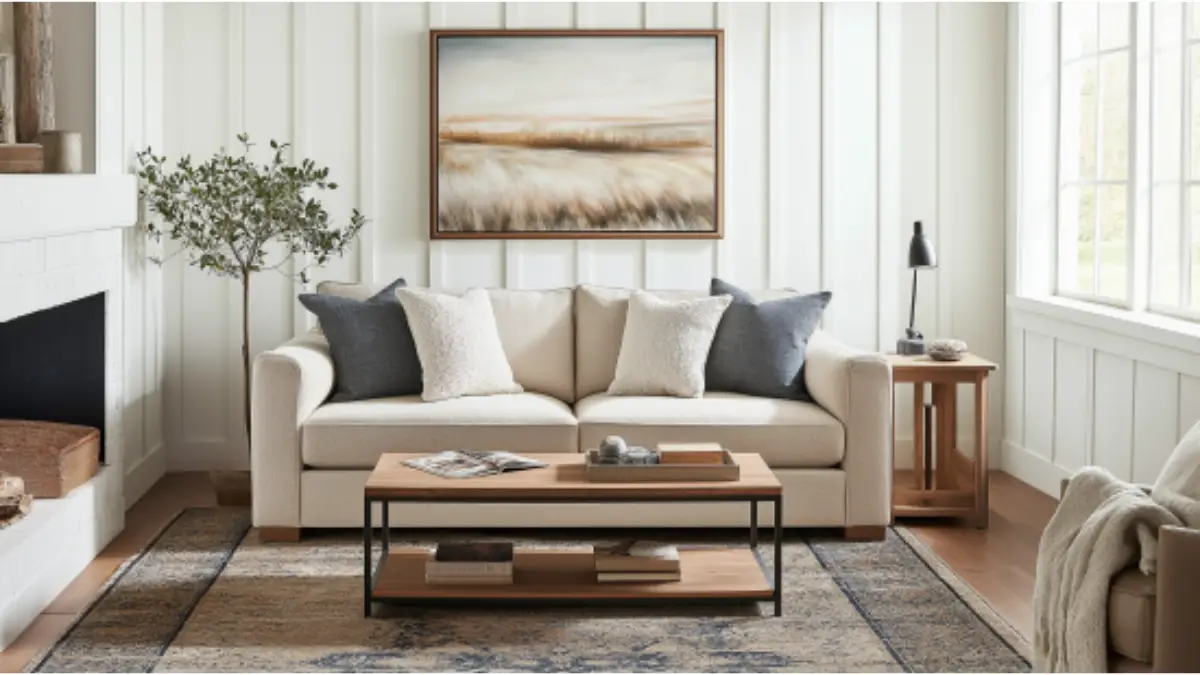Small Living Room Layout Hacks That Maximize Space Without Compromising
Table of Contents
Living in a small space doesn’t mean sacrificing style or comfort. In fact, with the right layout hacks, a small living room can feel surprisingly open, functional, and inviting. According to a 2024 survey by Houzz, nearly 60% of homeowners are focusing on better space utilization—especially in high-traffic areas like the living room.
From clever furniture placement to multipurpose decor, designing for small living rooms is all about strategy. Whether you’re in a studio apartment or looking to reimagine a compact family room, the challenge is the same: How do you make the most of every inch without cluttering your space?
This blog post explores practical, tried-and-true layout solutions that transform tight living rooms into flexible, stylish havens. You’ll learn how to float furniture to open up floor plans, why scale matters more than you think, and which visual tricks can expand your room instantly. We’ll also explore furniture picks, corner hacks, and zoning techniques to help you build a smart space you’ll love to live in.
Let’s dive into the best layout hacks to make your small living room feel bigger, brighter, and better designed.
Float Your Furniture to Open the Room
Most people instinctively push all their furniture against the walls in a small room, but that can actually make it feel tighter. Floating your furniture—especially your sofa—can create better flow and definition.
Instead of hugging the walls, bring your seating inward to create a more intentional conversation zone. This opens up walkways behind the furniture, which helps rooms feel more spacious. Use rugs to anchor the furniture arrangement, giving structure without visual heaviness.
Consider pairing a floating sofa with two small accent chairs rather than a bulky loveseat. Use a narrow console or storage bench behind the sofa to add function to the newly created space.
Tips for Floating Furniture
| Hack | Why It Works |
| Use area rugs | Defines the space without closing it off |
| Opt for leggy furniture | Open bases make the room feel airier |
| Add slim storage behind sofa | Creates storage without taking up space |
Choose Furniture That Does Double Duty
Multifunctional furniture is a game-changer for small living rooms. Think ottomans with storage, coffee tables that lift to become desks, or side tables with hidden compartments. The more purposes one piece can serve, the less furniture you need overall.
Look for items that are scaled to your room. A low-profile loveseat might work better than a full-size couch. Nesting tables, fold-out chairs, and even modular sofas give you the freedom to adapt the layout as needed.
Furniture that blends into the room visually—light wood tones, soft fabrics, or glass—also helps reduce visual clutter.
Double-Duty Furniture Ideas
| Piece | Function 1 | Function 2 |
| Storage Ottoman | Footrest | Hidden storage |
| Lift-top Coffee Table | Surface for decor | Workstation |
| Nesting Side Tables | Compact decor | Expandable surface |
Use Vertical Space with Wall-Mounted Solutions
When floor space is limited, go vertical. Wall-mounted shelving, sconce lighting, and floating media units free up the ground while offering plenty of storage or style potential.
For example, replacing bulky floor lamps with adjustable wall sconces saves precious square footage. Mounting your TV instead of placing it on a stand opens up space below for low storage or decor. Floating shelves can hold books, plants, or lighting to draw the eye upward and make the ceiling feel higher.
Built-ins can add even more vertical storage if you’re ready to invest in a custom look.
Vertical Layout Strategies
| Solution | Benefits |
| Floating shelves | Keeps floor clear, adds height |
| Wall sconces | Saves surface and floor space |
| Mounted media console | Stylish, compact entertainment zone |
Expand Visually with Light and Mirrors
Light and reflection can dramatically change how a room feels. Start by maximizing natural light—skip heavy curtains and use sheer or linen drapes instead. Position mirrors across from windows or light sources to reflect brightness and add depth.
Strategic lighting also matters. Layer ambient lighting (ceiling or recessed lights) with task lights (lamps or sconces) and accent lighting (LED strips on shelves). This helps avoid dark corners, which can make the space feel cramped.
Large wall mirrors or mirrored furniture pieces can double the perceived size of the room, especially when paired with a soft, monochrome color palette.
Visual Tricks for More Space
| Trick | Result |
| Mirror across window | Reflects light and expands the space |
| Light-colored walls | Keeps space feeling airy and open |
| Minimal window treatments | Maximizes daylight entry |
Create Distinct Zones in Open Spaces
In open-plan or studio setups, defining zones can prevent your small living area from feeling chaotic. Use rugs, lighting, and furniture placement to visually separate the living room from dining or office areas.
For instance, placing a rug under your sofa and coffee table anchors the space as a lounging area. A slim bookshelf or a console can serve as a visual divider between the living zone and another function.
Even color blocking—painting one wall a distinct shade—can help signal a functional shift in use without physical barriers.
Layout Zoning Techniques
| Method | Use |
| Rug under furniture | Grounds and defines the living space |
| Furniture as divider | Creates visual separation from other areas |
| Accent wall or paint | Subtle visual zone indicator |
Keep Corners Functional, Not Forgotten
Corners are often neglected, but in a small room, every inch counts. Corners can host vertical storage, cozy reading nooks, or small accent chairs. Consider triangular shelving, hanging planters, or a corner-friendly desk.
Don’t block sight lines, though—keep corner elements visually light or open. A tall corner plant in a woven basket can soften angles and add life without overwhelming the room.
Corner Utilization Ideas
| Corner Feature | Function |
| Triangle shelf unit | Displays books or decor |
| Armchair with floor lamp | Reading nook |
| Corner plant | Adds softness and height to the space |
Scale and Proportion Matter Most
One of the most overlooked aspects of small living room layout design is scale. Simply put, furniture and decor must be in proportion to the room size. Oversized sofas or bulky entertainment units can overpower a space, while undersized pieces may feel awkward and scattered.
Start by measuring your room and mapping out zones before shopping for furniture. A scaled floor plan helps prevent costly mistakes. Choose slim-legged furniture, open bases, and low-profile pieces to maintain sight lines and flow.
Another trick is to match the height of your furniture. Keeping chairs, tables, and sofas at similar visual levels helps maintain harmony and visual flow.
Tips for Proportional Layout
| Tip | Impact |
| Scaled-down sofa | Leaves space for movement |
| Matched furniture heights | Maintains visual harmony |
| Leggy pieces | Opens sightlines and adds airiness |
Flexible Layouts That Evolve
Small spaces benefit greatly from flexible design. Rather than locking into one layout, think in terms of reconfigurable zones that can adapt to your lifestyle.
Modular furniture is key—sectionals that move, ottomans that roll, and storage cubes that stack or shift. This approach allows you to entertain guests, work from home, or lounge without needing to redecorate entirely.
You can also rotate accessories with the seasons to keep things feeling fresh. Soft furnishings, artwork, and even lamp placements can subtly shift the vibe without major changes.
Elements of a Flexible Layout
| Element | How It Adds Flexibility |
| Modular sofa | Configurable seating options |
| Wheeled storage | Easy to move when needed |
| Seasonal soft goods | Refreshes look with minimal effort |
Conclusion
Designing a small living room doesn’t mean giving up style or comfort—it simply requires intention. By focusing on layout hacks that float furniture, double up function, maximize vertical space, and embrace flexibility, you can turn even the tiniest room into a welcoming, functional retreat. Remember, smart design choices are less about square footage and more about how you use it. With thoughtful planning and a few creative tweaks, your small living room can feel open, inviting, and effortlessly stylish.

